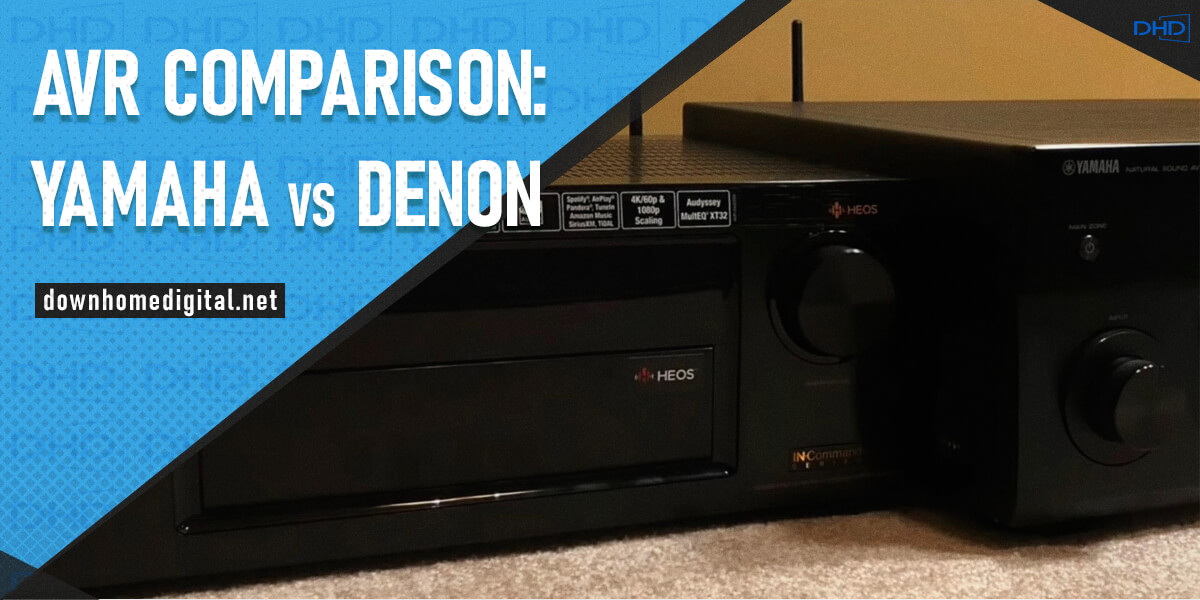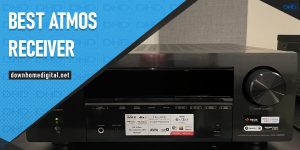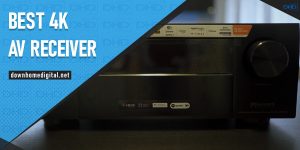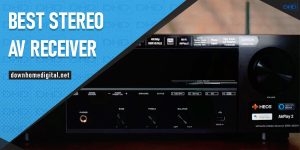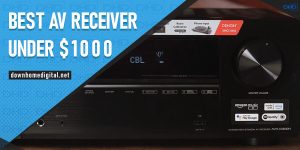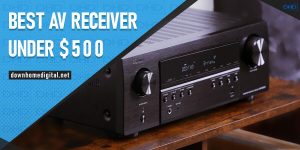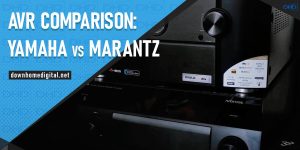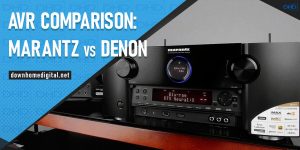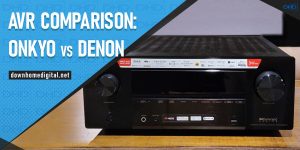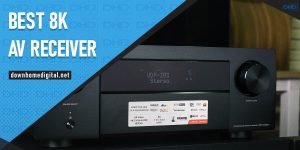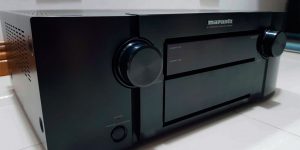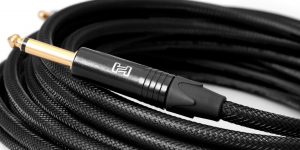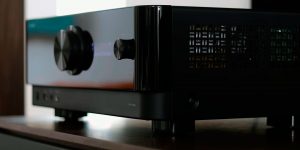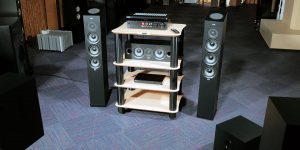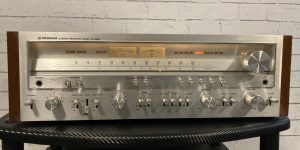The question of choosing the most suitable receiver arises for everyone who already has or wants to create a home theater. Therefore, I made a Denon vs Yamaha comparison by selecting the most interesting models from each manufacturer. Why these particular brands? Because they are recognized market leaders that please thousands of customers worldwide every year with their innovations in the world of advanced sound quality.
For testing, I selected models comparable in technical characteristics and main functions so that the results would be as honest and unbiased as possible. I pursued the goal to identify the strengths and weaknesses of models from entry-level to premium to determine which provides better performance.
Denon company history and overview
The Denon company was established at the beginning of the 20th century by Frederick Whitney Horn under Nippon “Denki Onkyo Kabushikigaisha.” In 1912, the Denon was purchased by Japan Recorders Corporation, a manufacturer of vinyl records and gramophones.
Almost two decades later, in 1928, the “Columbia” brand was added, and the company’s name changed to Japan Columbia Recorders. Eighteen years passed, and the company reorganized to Nippon Columbia. But in a year, a merger between Nippon Columbia and Denki Onkyo gave rise to DENON.
Since that time, Denon has specialized in domestic and pro audio and video devices and has earned numerous fans’ recognition for its products’ quality. Among Denon products, you can find receivers and electronic pianos, phono cartridges, amplifiers, tuners, speakers, turntables, professional CD players, and much more. Many audio enthusiasts know that Denon is always a great option!
Yamaha company history and overview
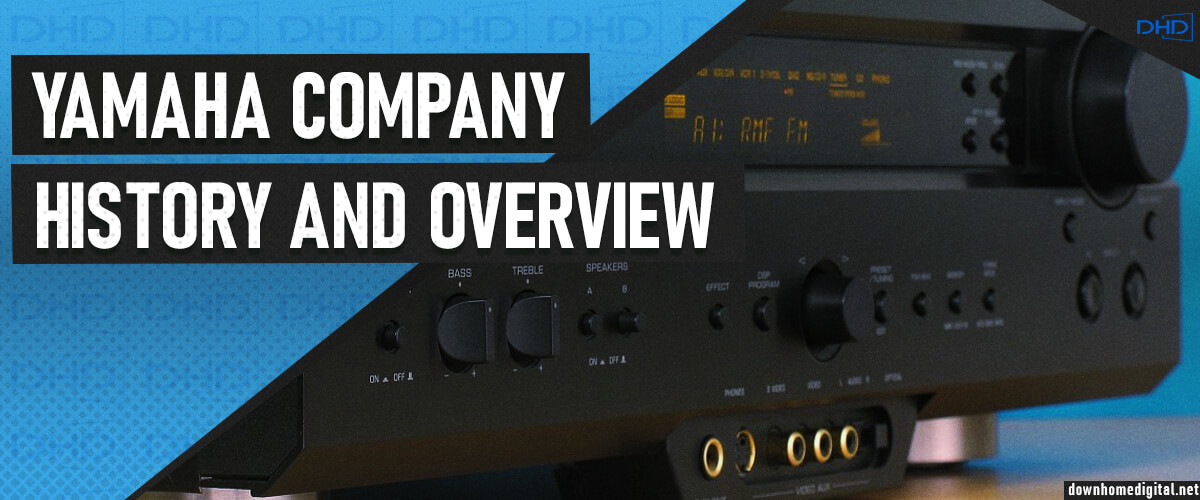
It was founded in 1887 as a piano and harmonium factory of Torakusu Yamaha as the Nippon Gakki Company, Limited in Hamamatsu. Over time, the production of musical instruments expanded and grew in quality. Initially, the company depended on the production and sale of pianos, but already at the beginning of the twentieth century, they tried pianos and organs.
By the 21st century, Yamaha began to produce a wide range of products, including pianos, drums, guitars, wind and brass instruments, symphonic percussion, violins, violas, cellos, and synthesizers and has also become a leader in the production of semiconductors and related products.
Now Yamaha is the largest manufacturer of musical instruments and equipment globally, with a brand that is the epitome of quality to fans. The same goes for the receivers. Yamaha is trying to surprise its fans and introduce something new and innovative.
How I tested receivers by Denon and Yamaha
Without comprehensive testing, it would be impossible to make the av receiver comparisons. My analysis included both the surround audio testing and the receivers` musical side.
For the comparison of Denon vs Yamaha sound quality, I chose the movie “Gravity.” It’s a great combination of special effects and dialogue. The perfect assistant for my analysis! And to test the musical side, I picked up a whole list of various artists and their hits:
- Led Zeppelin – Ramble On – SoundCloud
- Anne Sofie von Otter – Baby Plays Around – Deezer
- Steely Dan – Jack Of Speed – Spotify
- The Weeknd – The Hills (CD player)
- Winterplay – Billie Jean (CD player)
- Max Roach – Lonesome Lover (CD player)
- Daft Punk – Get Lucky (CD player)
And I conducted testing using the following devices:
- CD player SACD 30n
- Blu-ray player Sony UBP-X700
- Speaker wire – AudioQuest Type-9
- Speakers for movie – Klipsch RP-8060FA
- Stereo speakers:
- Klipsch RP-8060FA
- KEF Q350
- DALI OBERON 5
Mid-price Denon and Yamaha receivers comparison
Denon AVR-X4700H vs Yamaha RX-A6A
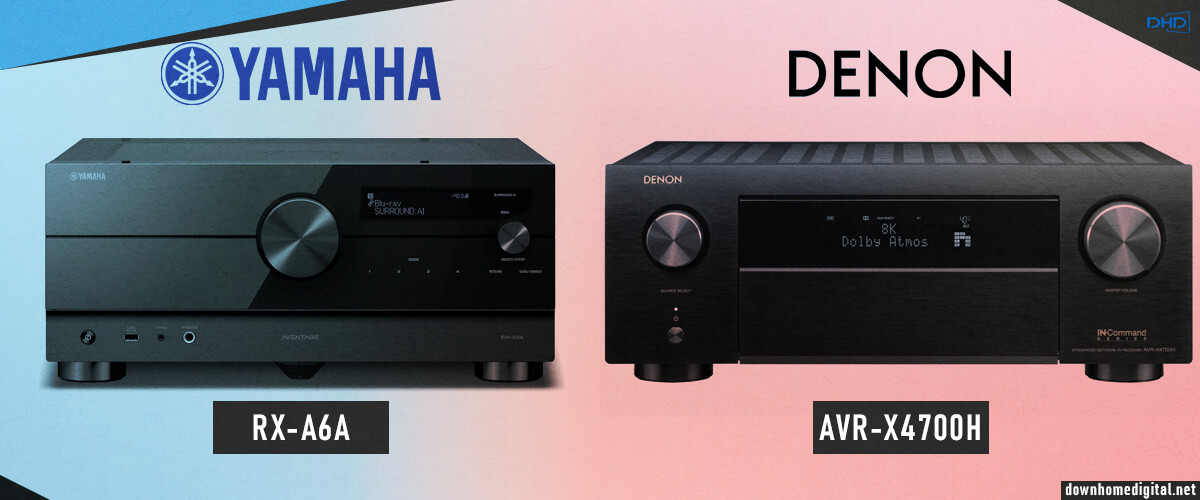
Let’s start comparing the receiver models that have become favorites among many lovers of hi-fi sound and quality video. You’ll learn the difference between these two devices so you can decide which will fit your home theater system better.
If we break down the comparison into some sort of categories, the first ones I prefer to describe are appearance and build quality. Specifically, I don’t have a single winner in this section because each model has several advantages and disadvantages. The AVR-X4700H, like all Denon receivers, has a classic, unremarkable look, but the manual controls are hidden under a protective cover (which is what they do with their expensive models). I really like the tactile feel when working with the brand’s AVR, as it’s designed to last a long time. All the buttons and controls don’t just look reliable (I’ve been working with this kind of tech for a long time); you won’t have any problems with them. The Yamaha RX-A6A, on the other hand, has a stunning, trendy, and memorable design (it was designed for the Aventage line). But I only work with these receivers with gloves on, as the touch controls mean the entire surface will be in your fingerprints. The weight of an AV receiver can say a lot (better quality components, good ventilation). So, in this case, the RX-A6A wins with its 41.2 pounds versus the Denon’s 30.2.
So, both Denon AVR-X4700H and Yamaha RX-A6A are 9.2 channel receivers. They have internal amplifiers, which make it possible to convert them into 7.1.2 or 5.1.4 systems. What may immediately rivet your attention is the audio capabilities of these channels. Denon AVR-X4700H generates 125W of power at 8 Ohm, while its rival puts out 150W at the same impedance. With the ability to expand both systems to 11 channels (with an external amplifier) for larger rooms or if you want more power, the Yamaha is your option.
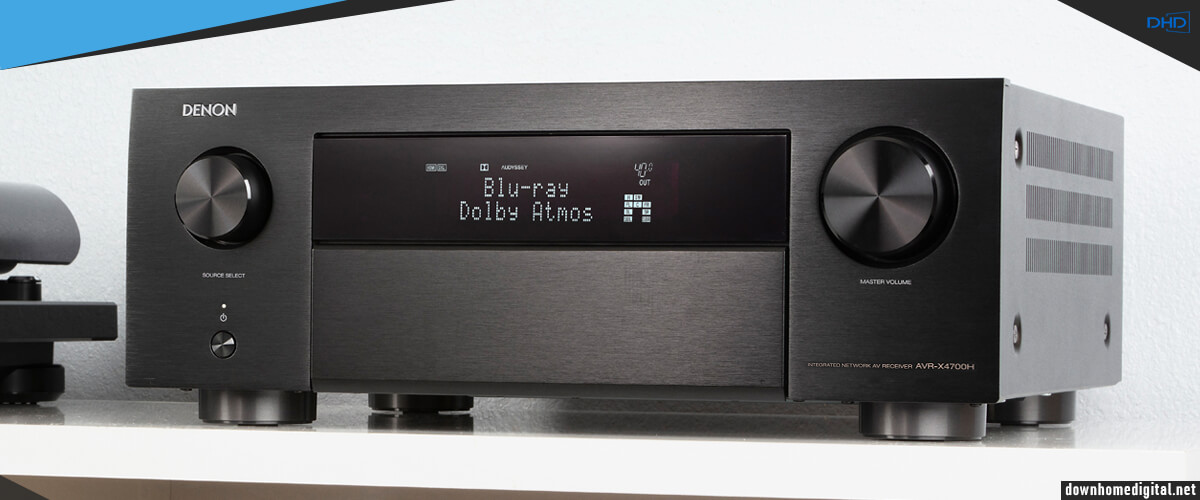
Having Dolby Vision, HDR 10, HDR 10+, Dolby Vision, and other video standards, you will enjoy the realistic image on the screen with both Yamaha RX-A6A and Denon AVR-X4700H. These devices support video conversion from analog to HDMI, with 480i/576i up to 8K 60/50 at the Denon receiver. The HDMI to HDMI scaling goes up to 8K 60/50 in the AVR-X4700H model. The pass-through capability of the video signal in Denon and Yamaha is 4K 120Hz and 8K 60Hz. You may need to use an upgraded cable to get 8K at 60 Hz resolution with Yamaha. As far as video upscaling is concerned, these devices come with the ability to upscale to 8K UHD. But in practice, I liked the way Denon handled it better. Minimal freezes (literally 1-2 for the whole movie for a few seconds). With Yamaha, I saw pixels showing up quite often.
Denon AVR-X4700H and Yamaha RX-A6A have seven HDMI inputs (plus Denon has one dedicated 8K input, but the Yamaha ones all have version 2.1 and work with 8K) and three outputs; one input is located at the front panel. Also, there are analog outputs, a phono jack, analog multi-room outputs, USB audio ports, and more. They also have Ethernet ports, Wi-Fi, and Bluetooth. Both receivers support major streaming platforms like Spotify and Pandora. In addition, you can use AirPlay2 to stream audio or video. Both receivers have built-in multi-room wireless audio systems: MusicCast for Yamaha and HEOS for Denon. All in all, they are quite modern all-in-one devices.
The latest surround sound formats are available in both models. When you choose the Denon AVR-X4700H or Yamaha RX-A6A, you can immerse yourself in the movie experience thanks to compatibility with Dolby Atmos, Dolby Atmos Height Virtualization Technology, DTS:X, DTS Virtual: XTM. Denon has IMAX Enhanced and supports Auro-3D, which makes it significantly different from the competition. After all, these surround sound formats are generally considered advanced.
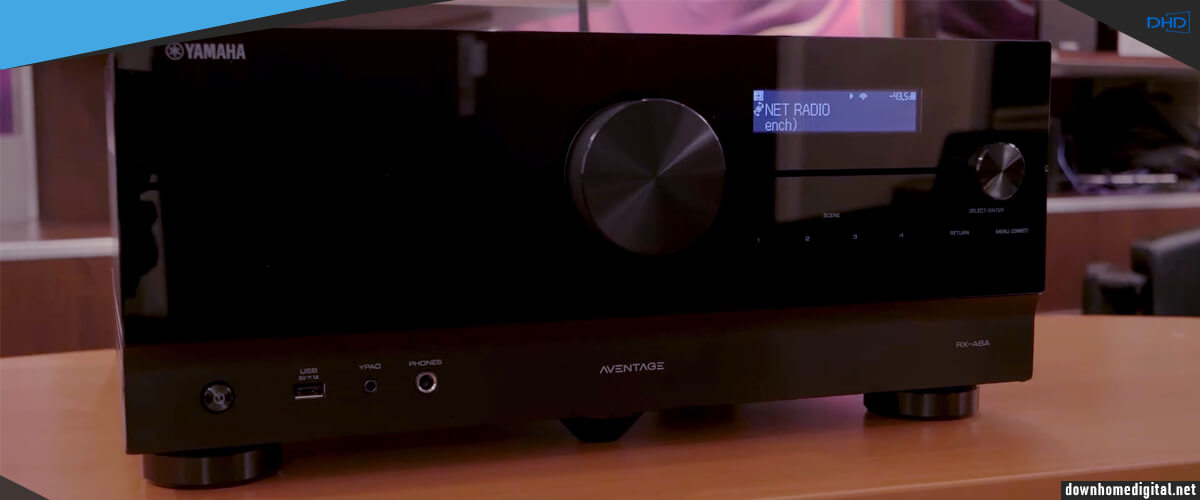
However, the RX-A6A owns such unique technology as CINEMA DSP HD3 for Dolby Atmos and DTS:X (it creates the acoustics of a theater hall, creating a unique picture). Another Yamaha development, Surround:AI, automatically optimizes the surround sound effect in real-time. This is significant, as its classic YPAO calibration system is far inferior to Denon’s Audyssey MultEQ XT32, which adjusts the system almost perfectly without manual intervention. This can come in handy for users with no experience.
The Yamaha’s sound is crisp and clean, with no distortion at any volume, from quiet to very loud. The sound is piercingly clear, crystalline, and even cold, a brand specialty. The Denon AVR-X4700H handles the sound well, providing decent stability and balance. However, the sound is warm, somewhat relaxed, and more realistic. When watching the same movie from The Fast and the Furious franchise, I liked the Denon better, which handled the car chase scenes superbly, emphasizing dialog and third-party sounds in the layers where they should be located. The Yamaha RX-A6A is far more suited to Transformers, where every sound matters. The meters showed high levels of dispersion, balance, and adherence to the frequency range. So, choosing the model that will better meet your sound quality expectations is a matter of your taste and preferences.
You’ll get great performance for whichever receiver you choose, Denon AVR-X4700H or Yamaha RX-A6A. With virtually identical features, these models from two popular brands will be the heart of your home theater, and warm or cool sound is purely a matter of taste. Both brands are incredibly popular because they balance value for money and quality construction designed to last for years.
From the important features, we can only emphasize that AVR-X4700H has only 1 HDMI input for 8K video (Yamaha has all of them), but the receiver provides better scaling to 8K. Also, Denon’s calibration system is much more convenient and performs better than Yamaha’s YPAO. But the company, aware of its shortcomings, has equipped its RX-A6A with a unique Surround:AI technology. There are some differences in support of surround sound formats (in favor of Denon), but Yamaha has a more powerful amplifier. Still, I’m ready to say that both receivers are versatile and suitable for movies and music. A difficult choice? Agreed. My verdict is a fighting draw!
| Key specs | Denon AVR-X4700H | Yamaha RX-A6A |
| Channels | 9.2 | 9.2 |
| Power output | 125 W/8 Ohm, 165 W/6 Ohm | 150 W/8 Ohm |
| HDMI inputs/outputs | 8/3 (8K/60Hz and 4K/120Hz pass-through) | 7/3 (4K/60Hz, 4K/120Hz, and 8K/60Hz pass-through) |
| Bluetooth/Wi-Fi | yes/yes | yes/yes |
| Video functions | video conversion analog to HDMI, analog to HDMI scaling, HDMI to HDMI scaling | analog to HDMI scaling, HDMI to HDMI scaling |
| Supports | HDMI ARC, HDMI eARC, HDMI CEC, HDCP2.3, HDR10, HDR10+, Dolby Vision | HDMI ARC, HDMI eARC, HDMI CEC, HDCP2.3, HDR10, HDR 10+, Dolby Vision |
| Streaming services | AirPlay2, Spotify, Pandora, Tidal | AirPlay2, Spotify, Pandora, Tidal |
| Surround sound | DTS-HD Master, Dolby TrueHD, DTS:X, Dolby Surround, Dolby Atmos, Auro 3D | DTS-HD Master, Dolby TrueHD, DTS:X, Dolby Surround, Dolby Atmos, Auro 3D |
Denon AVR-X4700H pros and cons
Pros
- Audyssey MultEQ XT32 room calibration technology is much better than Yamaha’s YPAO.
- IMAX Enhanced and Auro-3D.
- 8K scaling works better than Yamaha’s RX-A3080.
Cons
- Inferior to Yamaha RX-A3080 in terms of power.
- Only 1 HDMI input supports 8K.
Yamaha RX-A6A pros and cons
Pros
- More power (150W) than Denon AVR-X4700H.
- Surround:AI automatically optimizes the surround sound effect in real-time.
- Dolby Atmos and DTS:X with CINEMA DSP HD3 technology.
Cons
- YPAO calibration system is inferior to Denon’s Audyssey MultEQ XT32.
- Cold sound will not suit everyone.
Premium Denon and Yamaha receivers
Yamaha RX-A8A vs Denon AVR-X6700H
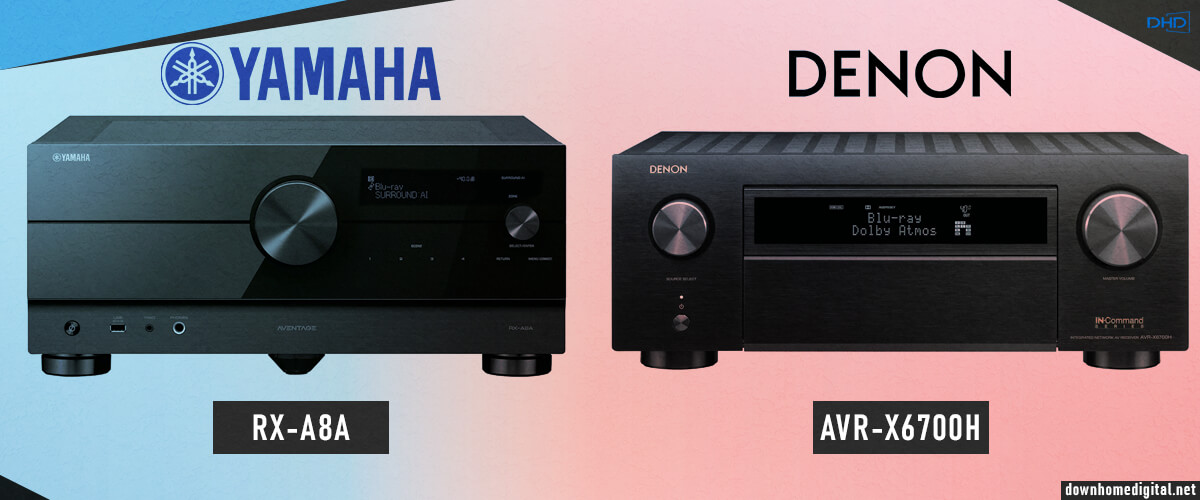
Well, I can’t do without comparing premium models – Yamaha RX-A8A vs Denon AVR-X6700H. Both receivers are very powerful, providing 140W (Denon) and 150W (Yamaha), and there is practically no difference in power in practice (remarkable THD allows you to listen to both at full power). However, there is a difference in channel processing. So, if you plan to expand your system in the future, you might like the AVR-X6700H better, as it can provide 13 channels with an additional amplifier. The RX-A8A has only 11 (which is not a small number at all). I would also note that the Denon model in question has an excellent DAC, consisting of an AL 32 and two dual SHARC chips and DSP cores. It copes with music and surround sound of any complexity and quality, conveying every detail and nuance.
As for design and construction, I can repeat word for word everything I said for the mid-price segment. But now I can spend more time on the weight of receivers and what it means. Remember once and for all, the heavier the receiver, the more quality components are used in it. The RX-A8A has an unbeatable 47.2 pounds versus the AVC-X6700H’s 32 pounds. It’s safe to say that you won’t have trouble with ventilation or noise in the electrical circuit. The Yamaha is larger, and the components inside it are arranged so that they don’t affect each other. The Denon is not a worse-order model, and its data is excellent, too. But when it comes to comparisons, things like this need to be highlighted, I think.
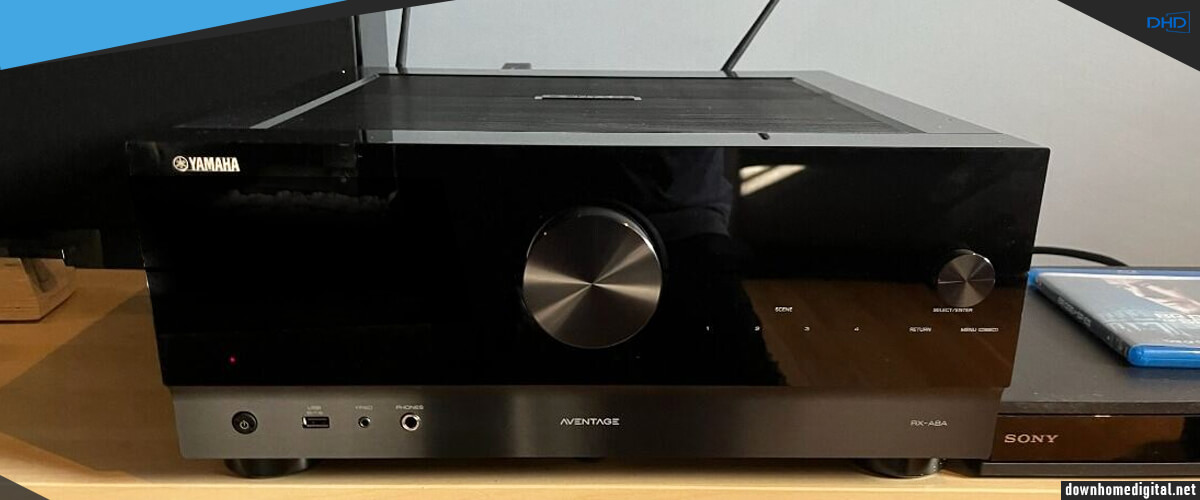
The Denon AVR-X6700H’s HDMI section is built on an older scheme (the model is from 2020): one of the eight inputs and two of the three outputs are modern-generation HDMI, so it fully supports 8K at 60Hz. But the other seven inputs are 4K only. The Yamaha RX-A8A (the 2021 receiver) has all 7 ports (1 less than Denon as a whole) supporting modern HDMI 2.1 version functionality (HDCP 2.3, eArc, CEC). But if you were to ask me, I don’t consider this factor to be fundamental to my choice (by the way, the Denon is cheaper today and much cheaper since discontinued) as there is still too little content in 8K resolution right now. Both receivers also support full gamification functionality.
When considering the premium segment, things are usually about as good as they can be when it comes to wireless connectivity. Not to spread myself too thin, I will say that both models support a myriad of streaming services and voice assistants and have built-in multi-room systems. I’ve tested everything I can think of and have been very satisfied. There are no “inherent” flaws with the Yamaha RX-A8A vs Denon AVR-X6700H, although they are both equipped with standard functionality. The only thing is that Denon’s Bluetooth doesn’t support the AAC codec like Yamaha’s. But I don’t really understand why you need Bluetooth at all with this kind of wireless technology equipment. As a result, your needs as an audiophile will be satisfied to the fullest.
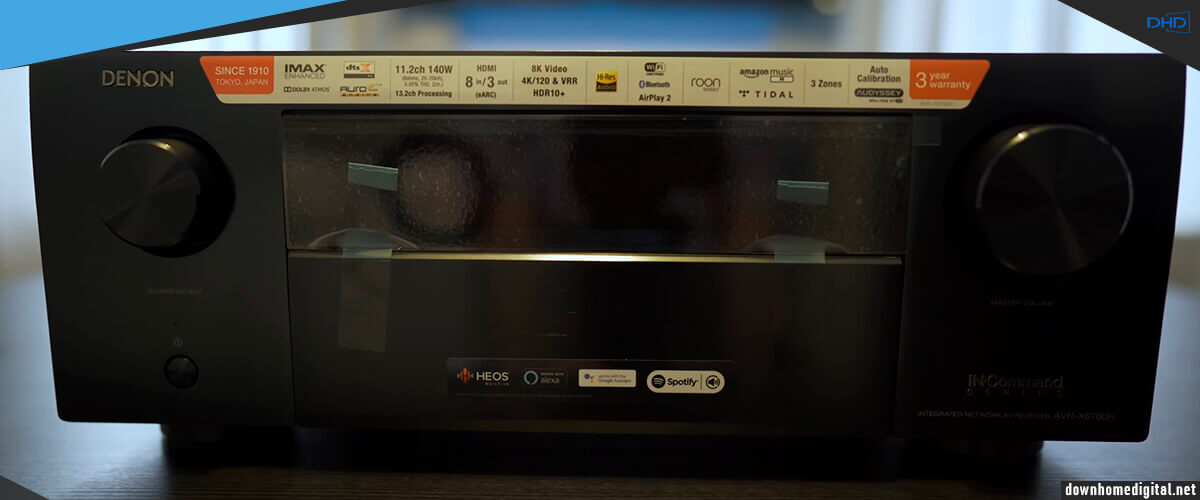
As for the main thing we’re here for today – surround sound – perhaps it’s worth mentioning the setup and features again. In addition to the difference mentioned above in the quality of automatic sound calibration, AVR-X6700H has two presets that can be saved in the settings. I think this is very convenient if you have different tastes in your family. But in the case of a large family, RX-A8A is more suitable because it has 4 service zones, 3 of which also provide video broadcasting. Denon has 3 audio and 2 video zones. But don’t forget about the additional amplifier, so the manufacturer compensated for the small number of zones.
In this comparison, both AVRs support Dolby Atmos, DTS: X, and Auro-3D surround sound formats. But as with the mid-range segment, IMAX is only available for the Denon. However, many will like the CINEMA DSP HD3 for concert sound from Yamaha. In general, in my Denon vs Yamaha receiver tests of receivers RX-A8A and AVR-X6700H, I was satisfied with the sound of the models (not surprisingly, they are expensive and justify their price). In the Denon device, everything is excellent in this respect, but I would like to note that the balance is shifted towards the lower register. As a result, the sound is perceived as controlled and mature. In addition, the extra bass volume provides full and realistic reproduction of voices and effects and, if necessary, can shake the room with its power. The basic character of the Yamaha sound seems slightly more neutral and restrained than the Denon AVR-X6700H with its understated timbres, but the sound seemed more balanced to me. Nevertheless, the average viewer without instruments and unique hearing will not note such details. The choice between warm and cool sound is still my focus. Though both of them made me shudder when watching the movie Arrival (2016). The breathing of scientists in spacesuits, the sounds of spaceships landing, the humming “voice” of aliens, or the quiet tears of a mother in her dying daughter’s room resonated in me as if I were present in the middle of the picture. It was an amazing experience.
So, after all this, my favorite is Denon, even though the Denon AVR-X6700H model is outdated in the field of video path (only 1 HDMI input with 8K video) and uses standard wireless connection options (like Yamaha in this case). Otherwise, the receiver is suitable for movies, music, and games, supports a huge number of surround sound formats (including IMAX), and realistically transmits any music genre. Given the quality of the internal components, particularly the excellent DAC, consisting of AL 32 and two dual chips, SHARC and DSP-core, the receiver will please you for a long time. Especially since by adding a stereo amplifier to it, you can end up with a 13.2 system.
Yamaha RX-A8A, in its turn, being inferior to Denon in the area of calibration, number of processed channels, and unfortunate (in my opinion) design, which requires maintenance, is also a great representative of modern home theater centers. It can be used for 4 zones (video for 3) as an audio source, supports a wide range of surround sound formats, and is great as a music supply (as well as gamification). It has unique technologies. And if you love its crystal sound, don’t listen to me and choose this model.
| Key specs | Denon AVR-X6700H | Yamaha RX-A8A |
| Channels | 11.2 | 11.2 |
| Power output | 140 W/8 Ohm, 175 W/6 Ohm | 150 W/8 Ohm |
| HDMI inputs/outputs | 7/1 (8K/60Hz and 4K/120Hz pass-through) | 7/3 (8K/60Hz and 4K/120Hz pass-through) |
| Bluetooth/Wi-Fi | yes/yes | yes/yes |
| Video functions | 4K/120Hz, 8K/60Hz pass-through, upscaling (up to 8K) | 4K/120Hz, 8K/60Hz pass-through, upscaling (up to 8K) |
| Supports | HDMI ARC, HDMI eARC, HDMI CEC, HDCP2.3, HDR10, Dolby Vision | HDMI ARC, HDMI eARC, HDMI CEC, HDCP2.3, HDR10, Dolby Vision |
| Streaming services | AirPlay2, Spotify, Pandora, Tidal | AirPlay2, Spotify, Pandora, Tidal |
| Surround sound | Dolby TrueHD, Dolby Atmos, Dolby Atmos Height Virtualization, Dolby Surround, DTS HD Master, DTS:X, DTS:X Pro, DTS Neural:X, Auro 3D | Dolby TrueHD, Dolby Atmos, Dolby Atmos Height Virtualization, Dolby Surround, DTS HD Master, DTS:X, DTS:X Pro, DTS Neural:X |
Yamaha RX-A8A pros and cons
Pros
- Massive 47.2-pound weight and optional anti-resonance design.
- 8K support on all HDMI ports.
- Multi-room video for 3 zones and surround sound for 4 zones (AVR-X6700H has only 3).
- Unique CINEMA DSP HD3 technology for concert sound.
Cons
- It only has 11 channels of amplification and the system cannot be expanded like the Denon AVR-X6700H.
- Plus the same drawbacks as the previous model.
Denon AVR-X6700H pros and cons
Pros
- Handles 13 channels (with an additional amplifier).
- The DAC consists of AL 32 and two dual SHARC chips and DSP cores.
- Two presets with different sound settings can be stored in the receiver’s memory.
- Suitable for gaming, music and movies.
- Great, powerful soundstage.
Cons
- Only 1 HDMI input has version 2.1 (8K support).
- Bluetooth does not support AAC codec.
Budget Denon and Yamaha receivers
Yamaha RX-V4A vs Denon AVR-S670H
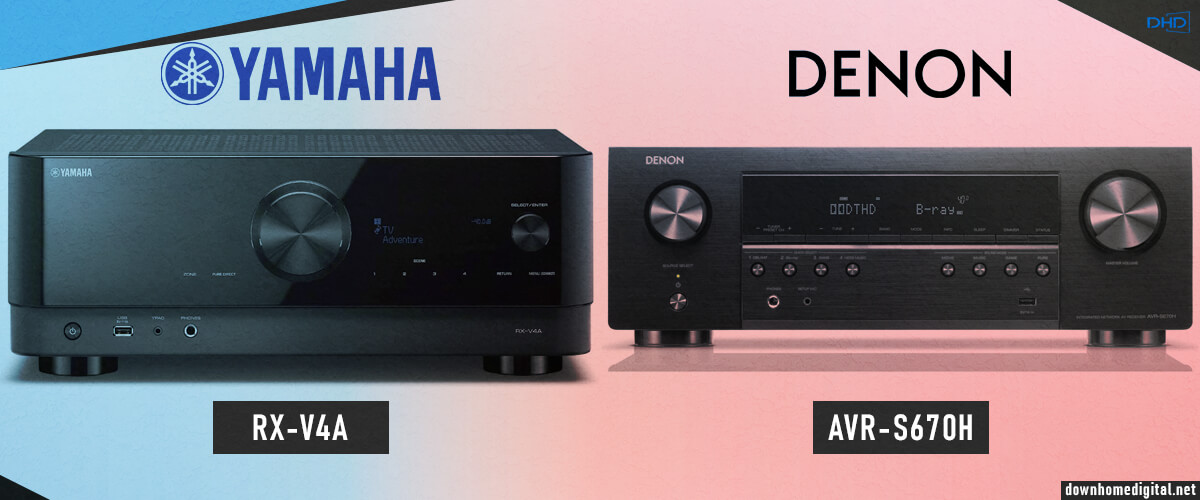
Let’s move on to a more budget level and compare receivers here. The Yamaha RX-V4A works in the 5.1 mode with a power of 80 W at 6 Ohm (0.06% THD) per channel. Enhanced immersion and realism are achieved with support for old surround sound formats like Dolby TrueHD and DTS-HD. Furthermore, it is simple to incorporate into the MusicCast system. The Denon AVR-S670H is also a 5.2-channel device with 75 W/8 Ohm (0.08% THD) or 100 W/6 Ohm per channel (but with a THD of 0.7% don’t count on full power, it wheezes at high volume). Again, the S670H has powerful DSPs, which support the more advanced Dolby and DTS formats in addition to basic multichannel formats (we’re talking about basic surround sound formats). Concurrently, it provides pretty wide settings for filters and equalizers.
As usual, I’ll start with the look and construction. Denon has a wonderful bright LCD, while Yamaha’s is practically invisible. But the S670H’s narrow button controls also contribute to me getting my fingers on the screen (the RX-V4A still has the same glossy case, even though it’s not part of the Aventage lineup). The enclosures on both models are light (17.2 and 19.4 pounds) and don’t resist vibration well. They overheat quite a bit at high volumes when operated for long periods. Well -that’s the price to pay for the low price. For budget receivers, such things are not just acceptable; they are expected and normal. And I liked Yamaha’s remote control better; Denon pays less attention to such things.
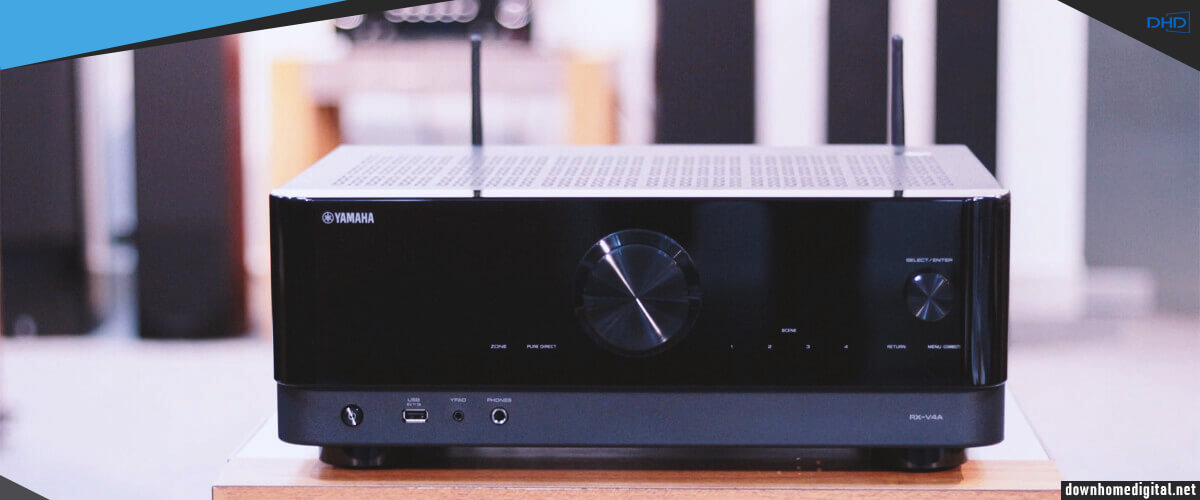
In addition to the specs mentioned above, the RX-V4A works with 4K resolution with 120Hz or even 8K with 60Hz on all HDMI ports (4/1). Alternatively, for example, the S670H’s HDMI switcher designed for 6 sources meets all modern 4K/3D/HDR/Dolby Vision standards and, importantly, is suitable for the most current video games. Only 3 of them are made according to the latest HDMI 2.1 specifications and pass 8K. This difference is consistent with the year of the receivers (2020 for Yamaha and 2023 for Denon).
During testing, I fully understood how each of the receivers sounds. The Denon AVR-S670H had natural, clear dialogue and sound effects that felt real and spatial in the film. I did not experience any significant problems even at higher volumes. I could hear a balanced and rich sound. All the same, it has a specific deficit of fast dynamics and firmness in the bass band. But the RX-V4A, with a similar sound, has good dynamics and a more balanced bass.
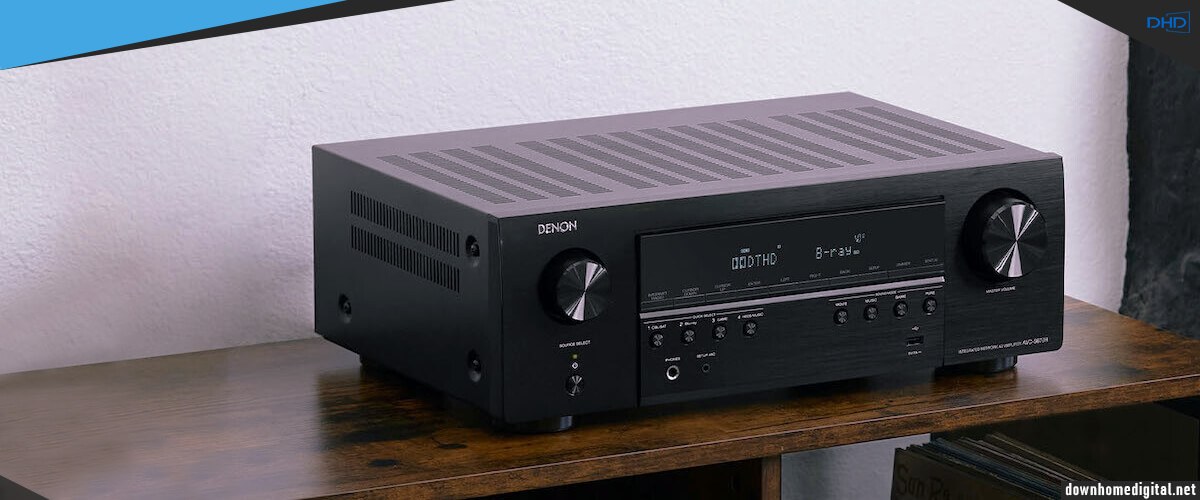
In music testing, I felt that the Denon AVR-S670’s sound field was ahead. Instruments and voices stood out very well. However, the bass seems a little weaker than in the movies. The dynamics were not impressive either. I was also not impressed with the work of Bluetooth, showing an unstable connection. But both HEOS and MusicCast work perfectly, so we can safely call both receivers, which are suitable for movies and music.
Testing has shown that even budget receivers can provide sufficient sound performance to create a home theater. But you shouldn’t expect too much from a 5-channel system. I would also caution you against expecting these receivers to last for long periods of time, although this depends on the frequency of operation and how much volume (power) you use. Their enclosures are unreliable, they are not resistant to vibration, and they overheat quite often and severely. The Yamaha RX-V4A and Denon AVR-S670 don’t have much power but will be enough for a small room (150 square feet). But all these shortcomings are acceptable and should not scare you. Just take them as a given.
If the choice were up to me, I’d go with the Yamaha RX-V4A in this case, as the 4 HDMI ports support 8K video (the Denon AVR-S670 only has 3, although the total number of ports is higher). It also has good dynamics, a more balanced bass, and better THD, although I’m not a fan of cold tones in movies. The AVR-S670 is easier to set up and operate and may be more beginner-friendly.
| Key specs | Denon AVR-S670H | Yamaha RX-V4A |
| Channels | 5.2 | 5.2 |
| Power output | 75 W/8 Ohm, 100 W/6 Ohm | 80 W/6 Ohm |
| HDMI inputs/outputs | 5/1 (4K/60Hz pass-through) | 4/1 (8K/60Hz and 4K/120Hz pass-through) |
| Bluetooth/Wi-Fi | yes/yes | yes/yes |
| Video functions | 4K/60Hz pass-through | 4K/60Hz pass-through, HDMI upscaling (up to 4K) |
| Supports | HDMI ARC, HDMI eARC, HDMI CEC, HDCP2.3, HDR10, Dolby Vision | HDMI ARC, HDMI eARC, HDMI CEC, HDCP2.3, HDR10, Dolby Vision |
| Streaming services | AirPlay2, Spotify, Pandora, Tidal | AirPlay2, Spotify, Pandora, Tidal |
| Surround sound | DTS HD Master, Dolby TrueHD | DTS HD Master, Dolby TrueHD |
Yamaha RX-V4A pros and cons
Pros
- Excellent THD of 0.06% for 6 ohms, no noise at maximum volume.
- Convenient remote control.
- 8K and 4K/120Hz on all HDMI connectors.
Cons
- Few HDMI ports (4/1).
Denon AVR-S670H pros and cons
Pros
- THD is worse than Yamaha’s. 100 W are listed for 6 ohms, but you won’t be able to enjoy them.
- Wide settings for filters and equalizers.
- More HDMI ports (6 vs. 4).
Cons
- Unstable behavior when transferring data via Bluetooth.
Stereo Denon and Yamaha receivers comparison
Denon DRA-800H vs Yamaha R-N303

And finally, let’s take a look at two stereo receivers – Denon DRA-800H vs Yamaha R-N303.
The Denon DRA-800H and the Yamaha R-N303 are rated at 100W/8 ohms, but the latter has a THD of 0.2% versus 0.08% for its opponent. In practice, this means you won’t be able to listen to the R-N303 at full power. This can be forgiven for the 2015 model; back then, sound clarity was not the main point of competition. The DRA-800H was released in 2019, and its amps are better quality.
For the same currently low price, I like the control and design of the Denon better. Since the Yamaha has bass and treble adjustments with buttons, you can’t adjust the system more subtly. With the DRA-800H, the EQ adjustments are made with round knobs that catch nuances very nicely. It also has a brighter and larger LCD. But the buttons are still mounted right under the screen, unlike R-N303, where you don’t touch the LCD when manually controlling it. The cases are fragile and light, as you should expect from inexpensive receivers. Still, for a stereo system, it is not critical (the AVR weighs 18.3 for Denon and 15.9 for Yamaha, which is almost identical to the weight of the 5-channel models I described in my review).
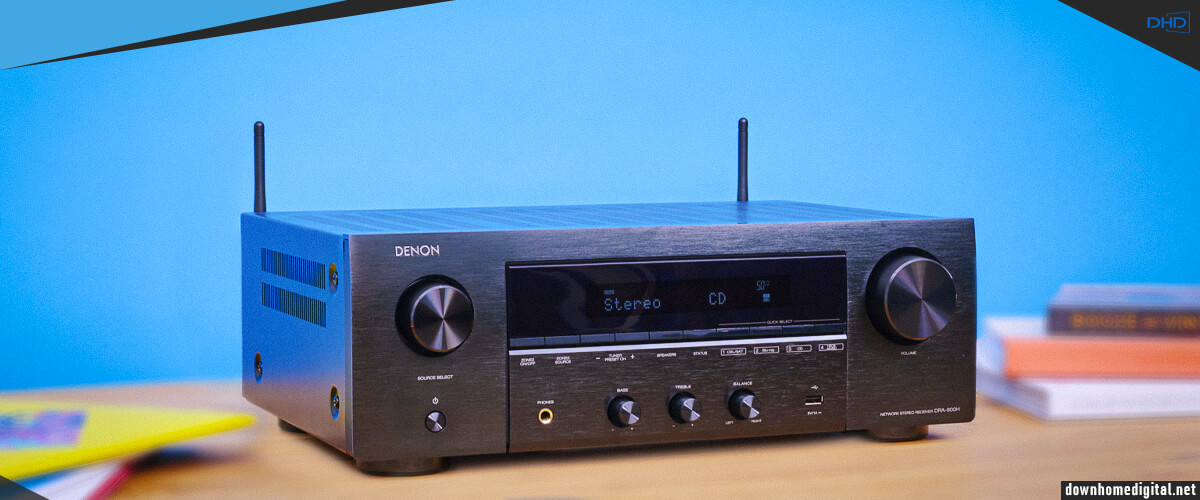
However, the main difference between the receivers is the ability to connect to a TV. Yamaha has a digital optical input for this purpose. But Denon has 5/1 HDMI ports, to which you can connect various sources and broadcast 4K video for your home stereo theater (if we can put it that way).
Yamaha has endowed the R-N303 with Top Art architecture. This symmetrical channel design contributes to excellent and accurate reproduction. Denon engineers have also placed great emphasis on the finest possible sound and have endowed the DRA-800H with all the standard Denon technologies and sonic characteristics. And on top of that, Denon has two preamps for the second zone and two subwoofers.
Moving on to online features, the Denon DRA-800H’s streaming features are based on the patented HEOS platform, which guarantees access to countless Internet radio stations as well as popular streaming services such as Spotify, Amazon Music, Deezer, and Tidal. But connecting to Wi-Fi had to be done several times. However, after that, everything worked stably.
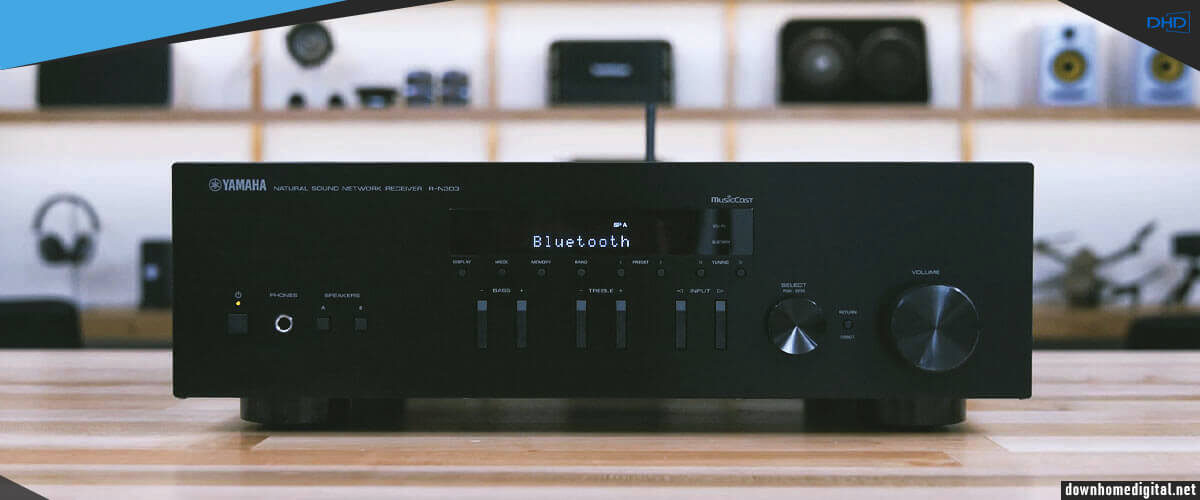
Its competitor, the Yamaha R-N303, has enormous networking capabilities, thanks in part to its MusicCast system, and there are so many ways to listen to music from the network. It’s worth noting that both models are compatible with Amazon’s Alexa and Google Assistant voice assistants.
When I started the Yamaha vs Denon testing, the Denon sounded fresh, dynamic, and determined, a little harsh in the mids and relatively soft in the lows, with open, expressive highs. The timbre here is not too rich and saturated, but thanks to this, the sound is distinguished by a great variety – it is easier to catch a change in timbre or intonation.
The sound of the Yamaha R-N303 is open and transparent but without dynamics and charge in any range. However, the three registers are well integrated, and my listening to music was satisfactory. I also found the R-N303 to be versatile and great for watching movies and TV shows.
As a result, I confidently can say that these receivers are on the threshold between entry and intermediate levels in sound quality. As a home theater and amplifier, they will deliver sound from your TV, console, turntable, and more in stereo to your living room. But it is obvious that Denon DRA-800H is a more modern device because it is equipped with HDMI ports (the signal of sound transmission is of higher quality, plus 4K video from external sources). In other words, it is a kind of hybrid. This model also has richer sound and cleaner THD (sounds louder). But still, expectedly for a budget receiver, there are problems with the Wi-Fi connection.
The Yamaha R-N303 is a standard stereo receiver without unnecessary options. But its control of the low and high-frequency settings is done push-button, depriving you of the opportunity to fine-tune the system. But since it is cheaper than Denon and was released in the distant 2015, such shortcomings are acceptable for it. The choice is yours to make. I remain an eternal fan of Denon and am ready to pay a couple of extra hundred dollars for quality, durability, and wide opportunities.
| Key specs | Denon DRA-800H | Yamaha R-N303 |
| Channels | 2.0 | 2.0 |
| Power output | 100 W/8 Ohm, 120 W/6 Ohm | 140 W/8 Ohm |
| HDMI inputs/outputs | 5/1 | 0/0 |
| Phono Input | yes | yes |
| Bluetooth/Wi-Fi | yes/yes | yes/yes |
| Streaming services | AirPlay2, Spotify, Pandora | AirPlay2, Spotify, Pandora |
Denon DRA-800H pros and cons
Pros
- Amplifiers are better, with cleaner THD.
- Has 5/1 HDMI ports 4K.
- More varied (richer) sound across genres.
Cons
- Connecting to wifi had to be done a few times. But after that, everything worked stably.
Yamaha R-N303 pros and cons
Pros
- The symmetrical design of Top Art channels contributes to excellent and accurate reproduction.
- Significantly improves TV sound (in stereo) and is good in music.
Cons
- Bass and treble are adjustable by buttons, and you can’t tweak the system more finely.
Discontinued models
Such famous companies as Denon and Yamaha are obliged to keep the bar, a certain benchmark among other brands. That’s why quite current models are often replaced by newer models that meet modern requirements. So pay attention to this pair. After all, the cost of receivers today is reduced, and their functionality can still satisfy most users.
Denon AVR-X3700H vs Yamaha RX-A1080
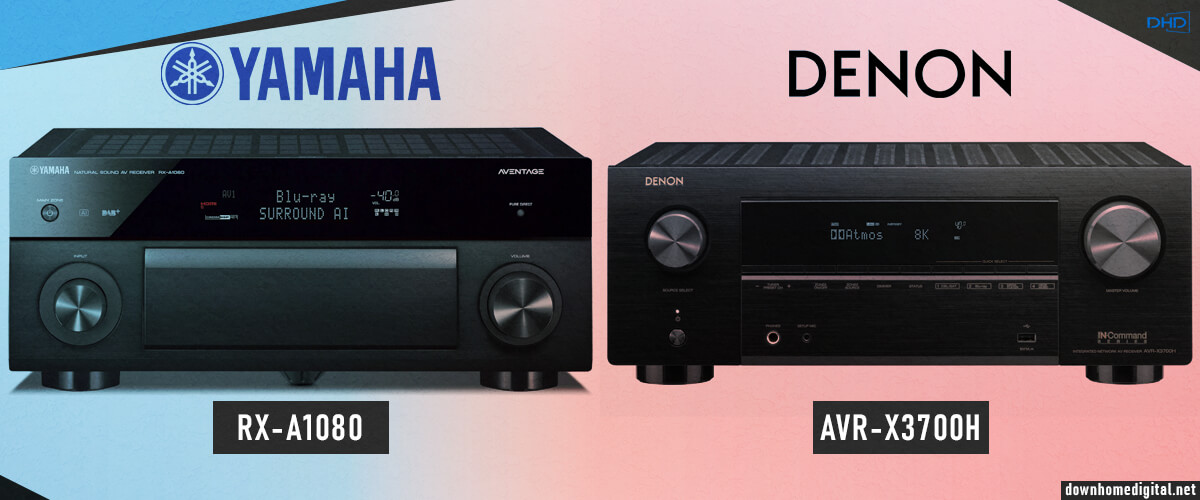
I present the Denon AVR-X3700H versus the Yamaha RX-A1080, a mid-segment confrontation.
The Yamaha RX-A1080 is a 7.2 channel unit that offers 150 W/8 Ohm superior to the competition. The AVC-X3700H operates with nine power amplifiers, delivering 180 watts per channel. Moreover, the A1080 has Dolby Surround and DTS Neural: X technologies on board. Unfortunately, Yamaha is still missing Auro 3D sound, and DTS Virtual: X is also losing.
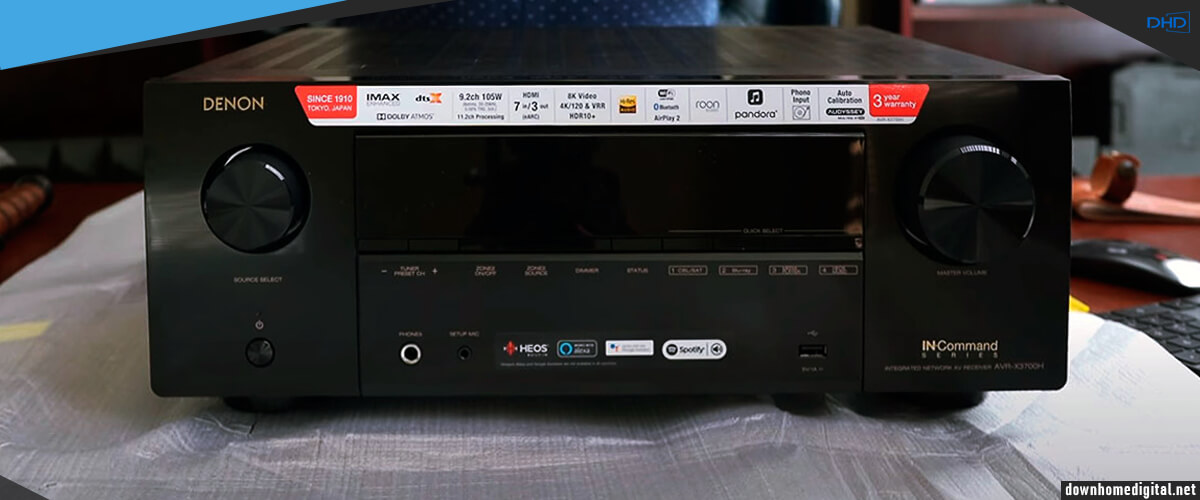
Denon’s HDMI circuit is the crucial advance about durability: one HDMI of the seven inputs and two of the three outputs are 2.1 version, with compatibility for 8K at 60Hz and HDMI upscaling up to 8K. In addition, all HDMI interfaces are compatible with HDR10+, Dynamic HDR, and Quick Media Switching. Furthermore, the RX-A1080`s HDMI video circuit works with 4K resolution with 60 fps transmissions and HDCP 2.2 copy protection with HDR10 and Dolby Vision.
In the Denon or Yamaha receiver testing, the X3700H’s aggressiveness piqued my interest during the test. The sounds were “elastic,” with decent detail accuracy. Furthermore, unique dynamic expressions that emphasize every on-screen action provide an even more immersive on-screen action.
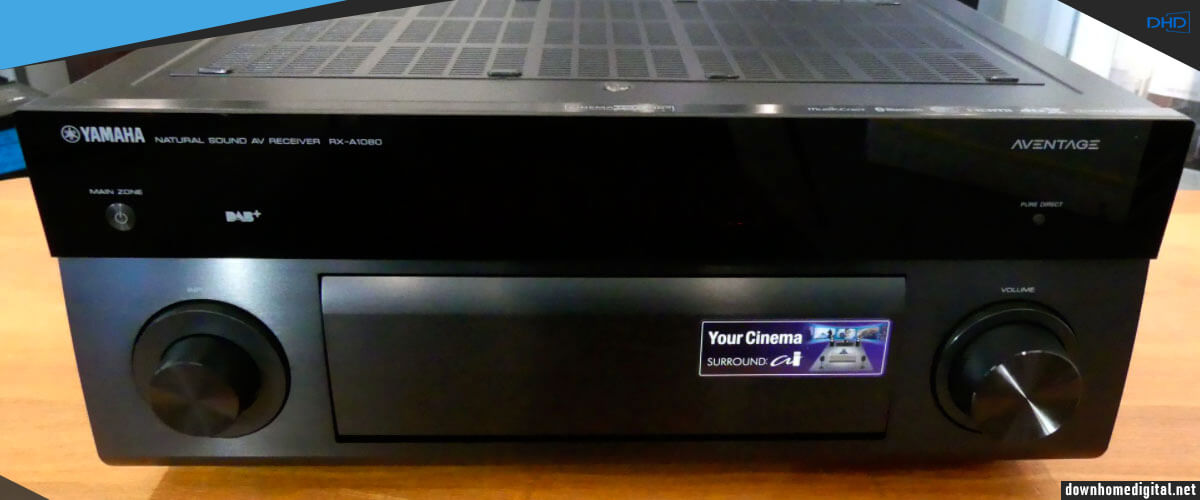
Yamaha also showed a high class in the home cinema test. As I expected, the sound was dynamic and precisely matched what was happening on the screen. Sound objects moved very realistically from speaker to speaker. On the music test, I had a similar result. The sculpted, booming bass also astonished me. Yamaha isolated the individual instruments and orchestras from the vocalists and choruses, resulting in a clean, undisturbed sound stage that was incredibly expressive for instrumental music.
To summarize, if you enjoy music and have a speaker set, the Yamaha RX-A1080 is ideal for this purpose. However, if you’re more interested in a home theater setup and your speakers match the AVR X3700H’s performance, Denon is your better choice.
| Key specs | Denon AVR-X3700H | Yamaha RX-A1080 |
| Channels | 9.2 | 7.2 |
| Power output | 105 W/8 Ohm, 135 W/6 Ohm | 110 W/8 Ohm |
| HDMI inputs/outputs | 8/3 (8K/60Hz and 4K/120Hz pass-through) | 7/3 (4K/60Hz pass-through) |
| Bluetooth/Wi-Fi | yes/yes | yes/yes |
| Video functions | HDMI to HDMI scaling | analog to HDMI scaling, HDMI to HDMI scaling |
| Supports | HDMI ARC, HDMI eARC, HDMI CEC, HDCP2.3, HDR10, HDR10+, Dolby Vision | HDMI ARC, HDMI eARC, HDMI CEC, HDCP2.3, HDR10, Dolby Vision |
| Streaming services | AirPlay2, Spotify, Pandora, Tidal | AirPlay2, Spotify, Pandora, Tidal |
| Surround sound | DTS:X, Dolby Atmos | DTS:X, Dolby Atmos |
Denon AVR-X3700H pros and cons
Pros
- Dynamic and immersive movie playback.
- HDMI 2.1 and 8K.
Cons
- No front Wide Channel support.
Yamaha RX-A1080 pros and cons
Pros
- Passionate, powerful, and subtle sound.
- Many DSP programs, including SurroundAI.
Cons
- No decoder for Auro 3D sound.

